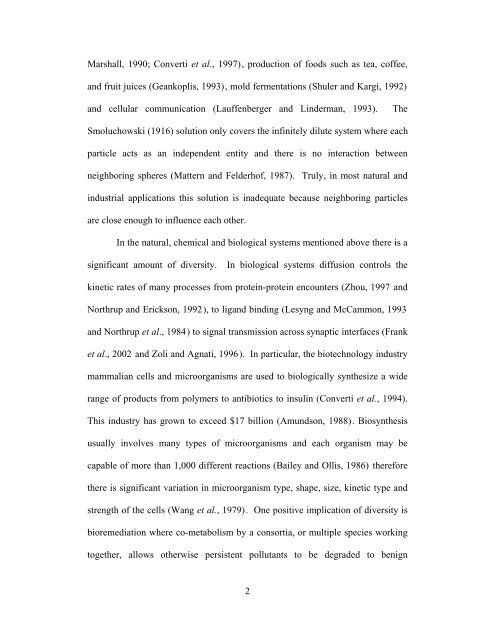Diffusion Reaction Interaction for a Pair of Spheres - ETD ...
Diffusion Reaction Interaction for a Pair of Spheres - ETD ...
Diffusion Reaction Interaction for a Pair of Spheres - ETD ...
Create successful ePaper yourself
Turn your PDF publications into a flip-book with our unique Google optimized e-Paper software.
Marshall, 1990; Converti et al., 1997), production <strong>of</strong> foods such as tea, c<strong>of</strong>fee,<br />
and fruit juices (Geankoplis, 1993), mold fermentations (Shuler and Kargi, 1992)<br />
and cellular communication (Lauffenberger and Linderman, 1993). The<br />
Smoluchowski (1916) solution only covers the infinitely dilute system where each<br />
particle acts as an independent entity and there is no interaction between<br />
neighboring spheres (Mattern and Felderh<strong>of</strong>, 1987). Truly, in most natural and<br />
industrial applications this solution is inadequate because neighboring particles<br />
are close enough to influence each other.<br />
In the natural, chemical and biological systems mentioned above there is a<br />
significant amount <strong>of</strong> diversity. In biological systems diffusion controls the<br />
kinetic rates <strong>of</strong> many processes from protein-protein encounters (Zhou, 1997 and<br />
Northrup and Erickson, 1992), to ligand binding (Lesyng and McCammon, 1993<br />
and Northrup et al., 1984) to signal transmission across synaptic interfaces (Frank<br />
et al., 2002 and Zoli and Agnati, 1996). In particular, the biotechnology industry<br />
mammalian cells and microorganisms are used to biologically synthesize a wide<br />
range <strong>of</strong> products from polymers to antibiotics to insulin (Converti et al., 1994).<br />
This industry has grown to exceed $17 billion (Amundson, 1988). Biosynthesis<br />
usually involves many types <strong>of</strong> microorganisms and each organism may be<br />
capable <strong>of</strong> more than 1,000 different reactions (Bailey and Ollis, 1986) there<strong>for</strong>e<br />
there is significant variation in microorganism type, shape, size, kinetic type and<br />
strength <strong>of</strong> the cells (Wang et al., 1979). One positive implication <strong>of</strong> diversity is<br />
bioremediation where co-metabolism by a consortia, or multiple species working<br />
together, allows otherwise persistent pollutants to be degraded to benign<br />
2
















